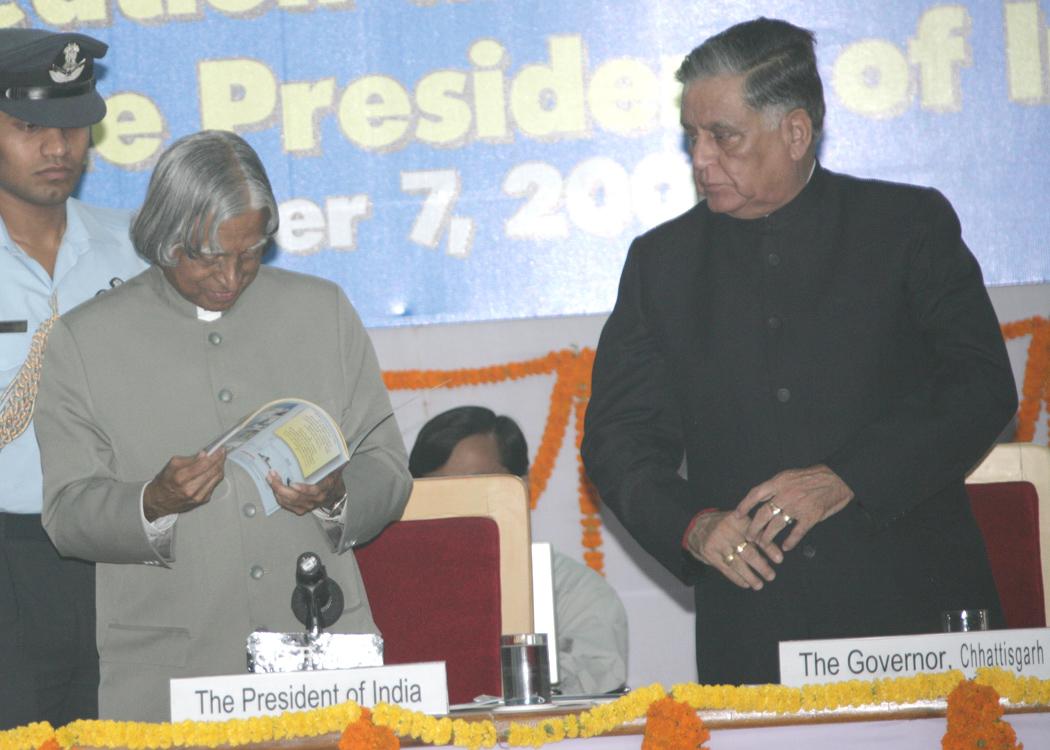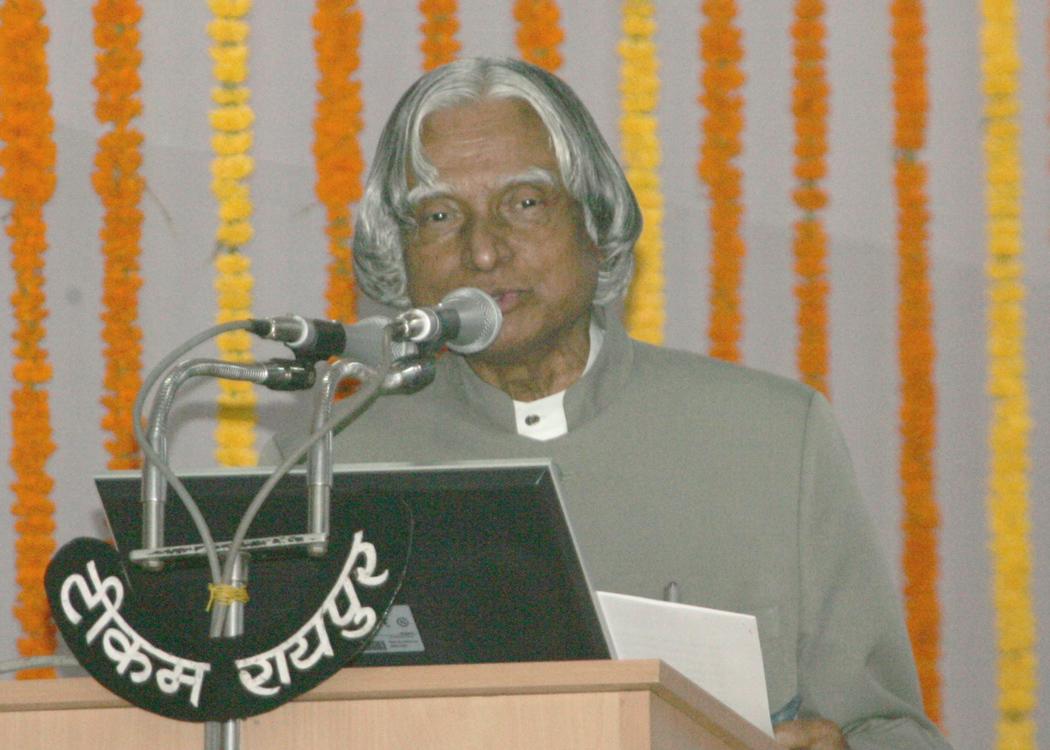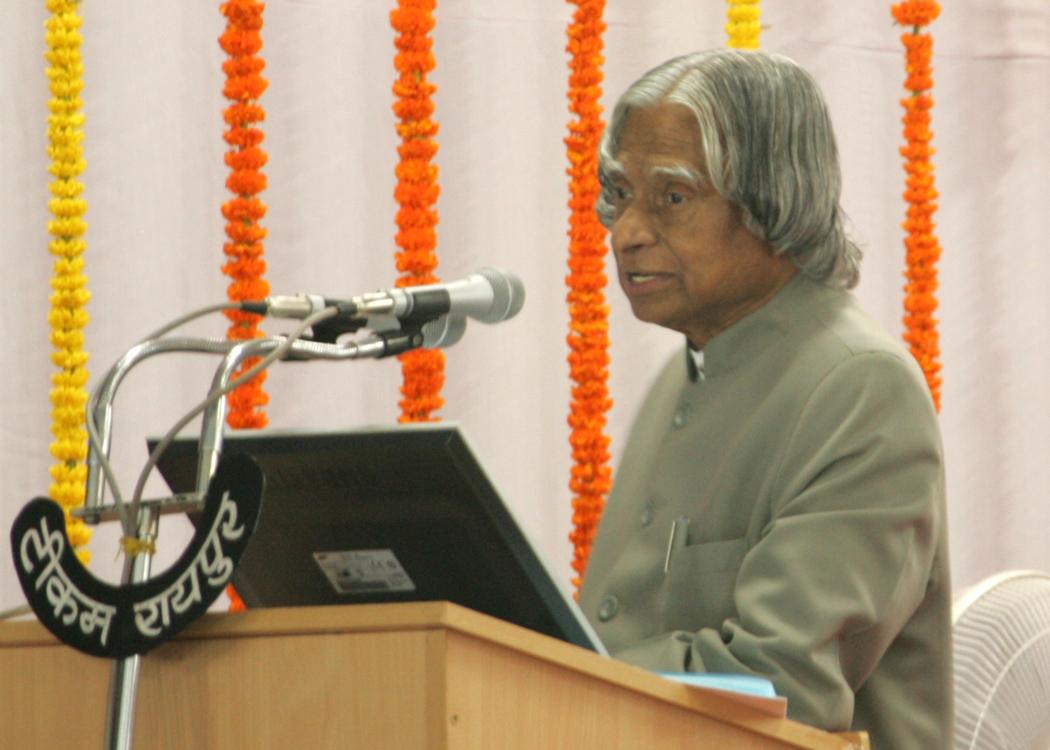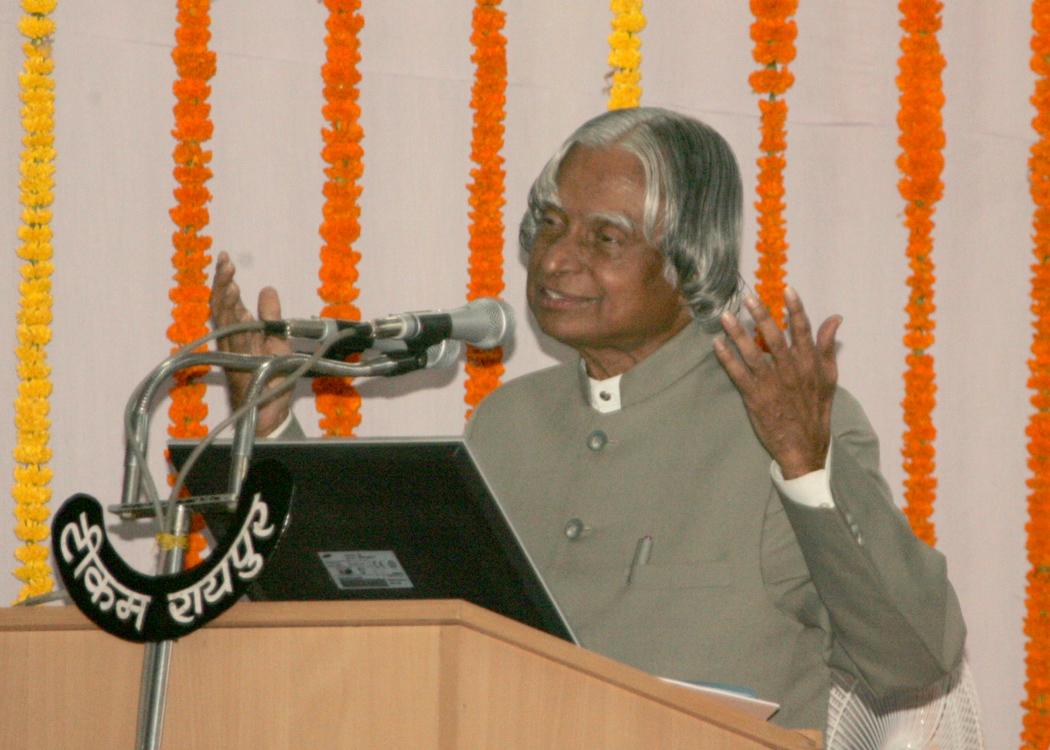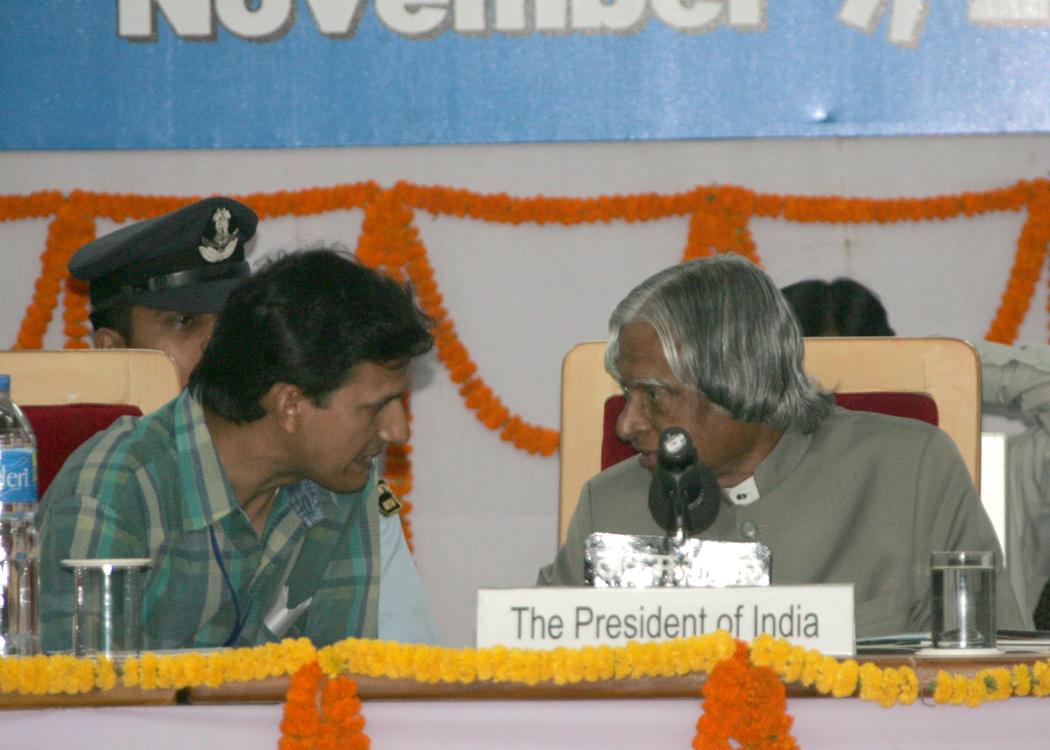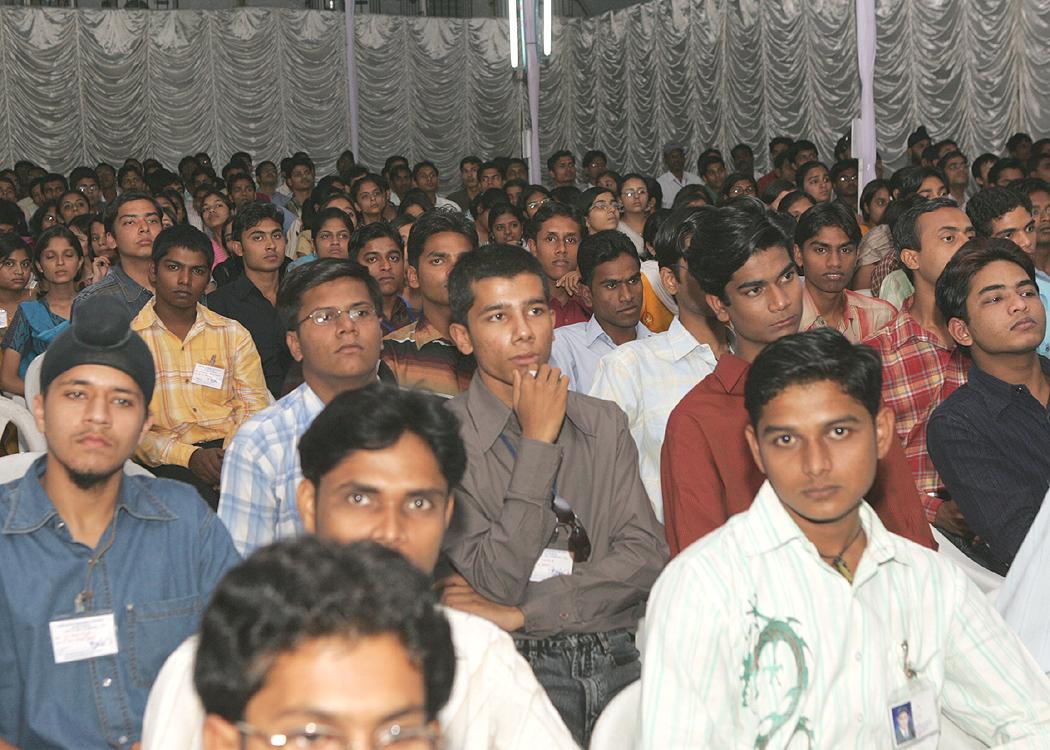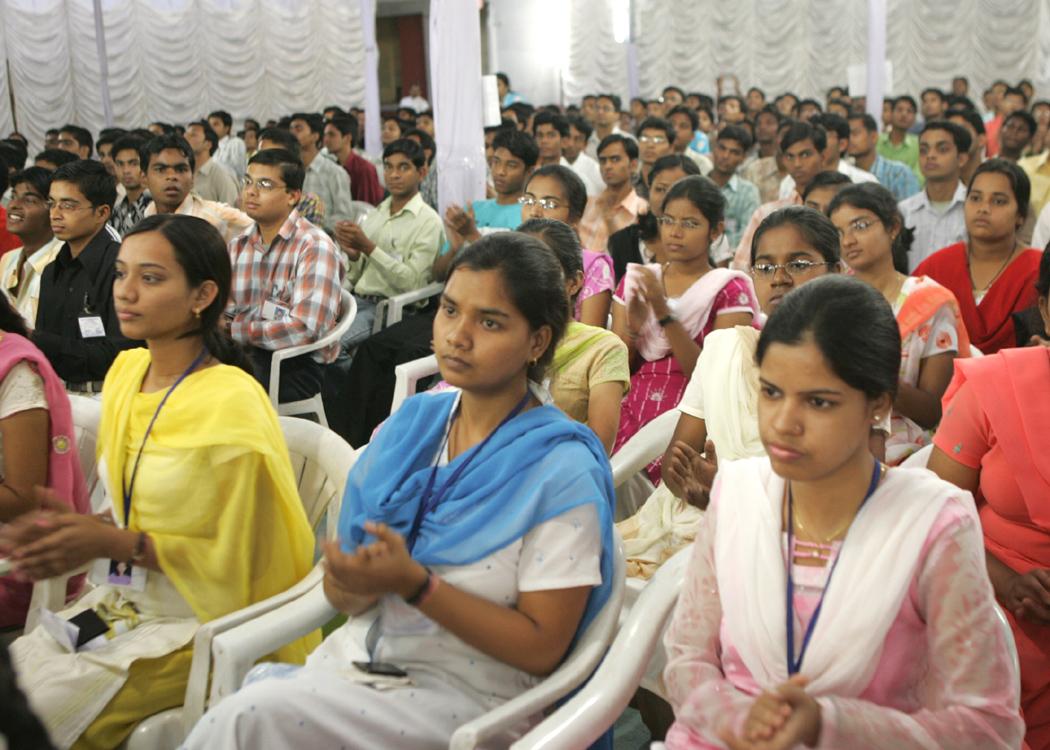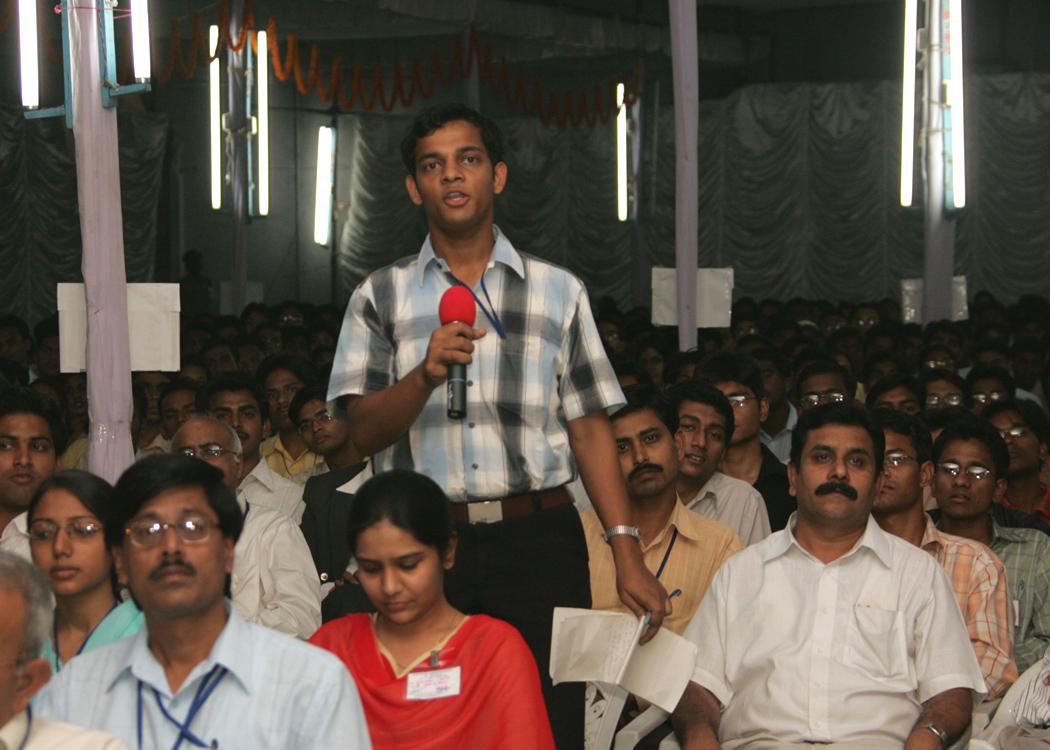Address and Interaction at the National Institute of Technology, Raipur,chhattisgarh
Raipur, Chhattisgarh : 07-11-2006
Evolution of Enlightened Society
Thinking provides knowledge
Knowledge makes you great
I am indeed delighted to participate in the interaction meet with the students of National Institute of Technology. I greet the students, and congratulate the Faculty and staff of NIT, for shaping the young minds. I always cherish interaction with the students and Faculty members. Since I am in the midst of students who have undergone value education organized in collaboration with ?Abhyudaya Sansthan, Achhoti?, I would like to talk on the topic ?Evolution of Enlightened Society?.
Evolution of enlightened citizenship
I would like to put forth to this intellectual gathering, an action oriented solution for evolving a happy, prosperous and peaceful society in our planet, which I call as ?Enlightened Society?. How do we create such an enlightened society, which has three components (a) Education with value system (b) Religion transforming into spirituality and (c) Economic development for societal transformation? Let us discuss.
(a) Education with value system: The best part for a person is his or her childhood and the learning period in school. The prime learning environment is five to seventeen years' of age. Of course, at home, love and affection are imparted. But again most of the time in a day is spent in preparing school's homework and study, eat, play and sleep. Hence the school hours for children are the best time for learning and need the best of environment and mission oriented learning with value system. During this stage, they need value based education in school and at home for them to become good citizens. This reminds me the echo from a great teacher's saying, "give me a child for seven years. Afterwards, let the God or devil take the child. They cannot change the child." This indicates the power of the great teachers. For parents and teachers, school campus and home have to have an integrated mission that is education with value system. They must inculcate moral leadership amongst children which involves two aspects. First it requires the ability to have compelling and powerful dreams or visions of human betterment, a state of things in which human beings could be better off in the future than they are now. Secondly, moral leadership requires a disposition to do the right thing and influence others also to do the right thing. If the child misses the value based education in the school, no government or society can establish a transparent society or a society with integrity. During this period, it is essential to elevate the young minds through a moral science class at least for one hour each week, delivered by great teachers. That will elevate the young minds to love the country, to love other human beings and elevate the young to higher planes. Throughout the world in every school till the age of 17, it is essential that moral science is taught. Such enlightened individuals will definitely promote peace and harmony in the planet. Now, I would like to share an experience that I have witnessed regarding religion transforming into a dynamic spiritual force.
My interaction with Shri Nagaraj: I had an opportunity to meet Shri Nagaraj and his team who are propagating the concept of Jeevan Vidya. Also I read his book. Teachings of Shri Nagaraj can form part of a value based education system. He says children must be allowed to gain the experiences of life. We need not impose our ideas on others. Freedom from illusion is a stage of moksha. We need to understand the meaning of existence, life and humane conduct. If we understand these three we will be sensible intelligent and wise. Shri Nagaraj further says the strength of life does not reduce with its utilization. We can feel it. Our strength and power increase and become stronger gradually with their utilization. These important messages will enable the students to understand their potential and contribute in a meaningful way to the society of which they are an integral part.
(b) Religion Transforming into Spirituality: Universal Mind
I would like to recall an incident which happened four decades ago. Prof Vikram Sarabhai is the visionary of space programme in India. He is well known for his cosmic ray research area that led to evolving the space research programme for the nation. Prof Vikram Sarabhai was looking for a site to establish space research station in the equatorial region. He visited a number of places. Thumba in Kerala was selected by the scientific community for space research as it was near the equatorial region and was ideally suited for ionospheric research in upper atmosphere apart from study of atmospheric structure. When Prof Vikram Sarabhai visited Thumba, the locality had series of villages and thousands of fishermen folk were living in that area. It also had a beautiful ancient church, St Mary Magdalene Church, Pallithura and a Bishop's House. Prof Vikram Sarabhai met many politicians and bureaucrats to get the place for the work of space science research. It did not move further because the nature of the place. He was asked to see the Bishop of Trivandrum, at that time in 1962, Rev Father Dr Peter Bernard Pereira. It was a Saturday when Prof Vikram Sarabhai met the Bishop. The Bishop smiled and asked him to meet him the next day, ie Sunday. In the morning after the Church Service, the Bishop told the congregation, "my children, I have a famous scientist with me who wants our church and the place I live for the work of space science research. Dear children, science seeks truth by reasoning. In one way, science and spiritualism seek the same divine blessings for doing good for the people. My children, can we give the God's abode for a scientific mission?" There was a chorus of 'Amen' from the congregation and the whole church reverberated. Subsequently, the big event took place in 1962. Rev Dr Peter Bernard Pereira, the Bishop of Trivandrum, took the noble decision to dedicate the church in recognition of the national goal for the establishment of the Indian Space Research Organisation at Pallithura, Thumba. That was the church where we had our design centre, started rocket assembly, design of filament winding machine for FRP product and the Bishop's house was our scientists' place. Later, the Thumba Equatorial Rocket Launching Station (TERLS) led to the establishment of Vikram Sarabhai Space Centre (VSSC) and multiple space centres throughout the country.
When I think of this event, I can see how enlightened spiritual and scientific leaders, all converge towards giving reverence to the human life. New church and new schools were established in record time. Of course the birth of TERLS and then VSSC gave the country the capability of design, development and produce world class huge rocket system and subsequently, India has the capability of launching geo-synchronous, sun-synchronous and meteorology spacecraft, communication satellite, remote sensing satellite thereby provided fast communication, weather forecasting and also locate water resources for the country. Today, among us, Prof Vikram Sarabhai is not there, Rev Dr Peter Bernard Pereira is not there, but those who are responsible for creation and make the flower blossom will themselves be a different kind of a flower as described in the Bhagwat Gita: "See the flower, how generously it distributes perfume and honey. It gives to all, gives freely of its love. When its work is done, it falls away quietly. Try to be like the flower, unassuming despite all its qualities". What a beautiful message for all generation of this nation, on integration of minds and universal mind. No where in the world a church has been given for scientific research, it has happened in India. It is a great message to be spread. The message is, the best component of the religion can be transformed into a spiritual force that will shape the society. Let me now discuss with you the third component of the enlightened society for transforming the developing nation into a developed nation through achieving economic prosperity, so that large societal imbalances can be removed. In this connection, let me take an example of India, which has one sixth of the global population.
(c) Transforming our nation into a economically developed nation
We have a population of over one billion people of which 220 million are still living below the poverty line. They need education, they need habitat, they need health care, and creation of employment potential. To meet their needs we have the second vision of transforming India into a developed nation by the year 2020. We have identified five areas where India has a core competence for integrated action: (1) Agriculture and food processing (2) Education and Healthcare (3) Information and Communication Technology (4) Infrastructure development such as power, transportation, communication and including Providing Urban Amenities in Rural Areas (PURA) network and (5) Self reliance in critical technologies. These five areas are closely inter-related and if implemented in a coordinated way, will lead to food, and economic security, and national security. A strong partnership among the R&D, academy, industry and the community as a whole with the Government departments will be essential to accomplish the vision for a developed India. Indian GDP is growing at an average rate of 8% p.a. whereas the economists suggest that to remove the poverty of 220 million people we have to grow at the rate of 10% p.a. consistently for over a decade. One of the components through which the rural-urban divide will be bridged and prosperity will be brought to the seven hundred million people living in six hundred thousand villages is Providing Urban Amenities in Rural Areas (PURA) in seven thousand clusters. Through a national vision, using the core-competence of individual states and partnership of knowledge institutions, it will definitely be possible, to transform a developing state into a developed state as planned.
The three dimensional approach indeed will lead to evolution of a peaceful, happy and safe society.
Conclusion
Human evolution is accompanied by conflicts and problems. I have presented a dynamic model which calls for transformation of the world community into a prosperous, peaceful and happy society through three major components. Dear friends, I heard a divine hymn in a spiritual atmosphere, I am going to recite. May I request you to join me.
Righteousness
Where there is righteousness in the heart
There is beauty in the character.
When there is beauty in the character,
There is harmony in the home.
When there is harmony in the home.
There is an order in the nation.
When there is order in the nation,
There is peace in the world.
My best wishes to all the members of NIT, success in their mission of promoting value based education among the students.
May God bless you.
Question and Answer Session
1. To fulfill Vision 2020, we need lots of entrepreneurs. Unfortunately, few of Engineering Students opt for entrepreneurship. Most tread the beaten path of job security due to lack of confidence. How this can be overcome? Whether values can play a role?
- Wali Mohd. Khan, BE (Elect. & Tele.) Vth Semester
Ans: I have always been advocating, that along with the degree course, there is a need for a full-fledged entrepreneurship course of six months duration with the award of a diploma. The aim of the course is to inculcate the spirit of ?I can do it? among the student. This course must provide case studies on success stories of entrepreneurs. Also it must train the students about the successful working with the banking system, particularly for venture capital operations. I am sure our universities will built the entrepreneurial capacity among our students. While taking up entrepreneurship values will definitely play an important role in providing moral leadership to the entrepreneur. University system should aim to create employment generators instead of employment seekers.
2. It is the technological advancement and technological experts which have damaged the nature most. Is there the need to redefined the current paradigms of development and advancement?
- Surabhi Tiwari, BE (Elect.) VIIth Semester
Ans: Technology is a double edged weapon. It can be used for good purposes and also certain negative purposes. For example, we can use nuclear energy for generating electric power. The same nuclear energy can also be used as a weapon. Now, when there is a so much of degradation of nature in the planet. There is a need to deliberately think of using the technology for preserving and sustaining the nature. For example, instead of using fossil fuels, we should think in terms of using wind, solar and tidal energy. Similarly, we should maximum use bio-diesel and bio-ethanol. In the construction area we should apply the concept of green buildings. In addition, technology must be put use for converting waste into wealth, such as electricity generation from municipal waste and fly ash for construction of roads and as manure. The energy required for converting fly as into bricks is much lower. Also there is a need for interlinking of rivers for reducing the damage due to floods and provide adequate water to drought prone areas.
3. Engineering education doesn?t teach me, how to live in harmony with various relationships, particularly in family. How can I be successful in my family relationship in future ?
- Shubhumkar Banerjee, BE (Computer Science) Vth Semester
Ans: While I was in college, I remember the lectures given by highest authority of the Jesuit institution Rev Father Rector Kalathil of St. Joshep?s college, Trichirappalli, Tamilnadu. Every week on Monday, he will take class for an hour. He used to talk about good human beings, present and past, and what makes a good human being. In this class he used to give lectures on personalities such as Buddha, Confucius, St. Augustine, Califa Omar, Mahatma Gandhi, Einstein, Abraham Lincoln including some scientific personalities and moral stories linked to our civilizational heritage. He also used to talk about great personalities living in the father?s lodge and who had made contribution with values in the service of the people. It is essential in the secondary schools and colleges to arrange a lecture by a great teacher of the institution once in a week for one hour on India?s civilizational heritage. This class can be called as a Moral Science Class. That will elevate the young minds to love the country, to love the other human beings and elevate the young to higher planes.
All relationships are governed by the basic principles of mutual trust and mutual love. We have to understand that we are part of a large system with positive connection with every other element. In the family system, we have to cultivate the habit of respecting the elders. Whatever they do for us we should know that, they are going to do it for our good. If we follow this principle in our relationship with elders, youngsters and the equals, we will certainly have successful relationship with every one. One principle, we should follow is ?do not do anything to others, what you would not like to be done to you?.
4. The demographical composition of India will make India the youngest country in world in near future. But if these millions of youngsters are not developed as human resource this advantage may be lost and may become a disadvantage. How the country can meet this challenge successfully and what the government is doping about it.
- Vasu Pandey, BE (Electronics & Telecommunications) Vth Semester
Ans: In the 21st century, India needs large number of talented youth with higher education for the task of knowledge acquisition, knowledge imparting, knowledge creation and knowledge sharing. At present India has five hundred and forty million youth under the age of 25 which will continuously be growing till the year 2050. Keeping this resource in mind, the Universities and educational systems should create two cadres of personnel: (1) a global cadre of skilled youth with specific knowledge of special skills (2) another global cadre of youth with higher education. These two cadres will be required not only for powering the manufacturing and services sector of India but also will be needed for fulfilling the human resource requirements of various countries. Thus, the universities and secondary school education system will have to work towards increasing the through put of the higher education system from the existing 6% to 20% by the year 2015, 30% by the year 2020 and 50% by the year 2040. The other Indians who are not covered by the higher education system should all have world class skill sets in areas such as construction, carpentry, electrical systems, repair of mechanical systems, fashion design, para-legal, para-medical, accountancy, sales and marketing, software and hardware maintenance and service, software quality assurance personals etc. No Indian youth should be without either a world-class higher education or without world-class skills sets. This is the mission, which must be undertaken by all our Universities and the educational systems with a policy direction from the Ministry of Human Resource Development.
5. First green revolution resulted in food sufficiency for India but in its wake it has also given many problems and issues. Now there is talk of another green revolution, what should be done so that mistakes of the past are not repeated and sustainable agriculture system beneficial to the country, the farmer and ecology can emerge.
- Swathi K.S., BE (Bio-technology) Vth Semester
Ans: Unlike first green revolution the emphasis in second green revolution is starting with soil to seeds to food grain to food processing and marketing. This value change will definitely be beneficial to the country to the farmer and the ecology as a whole.

